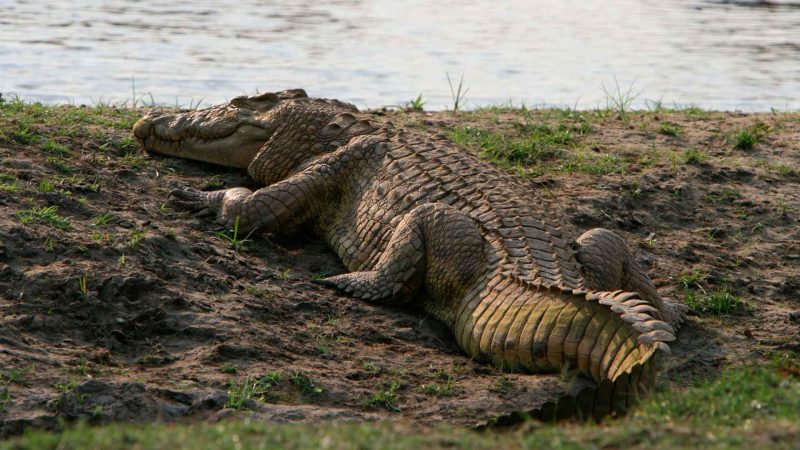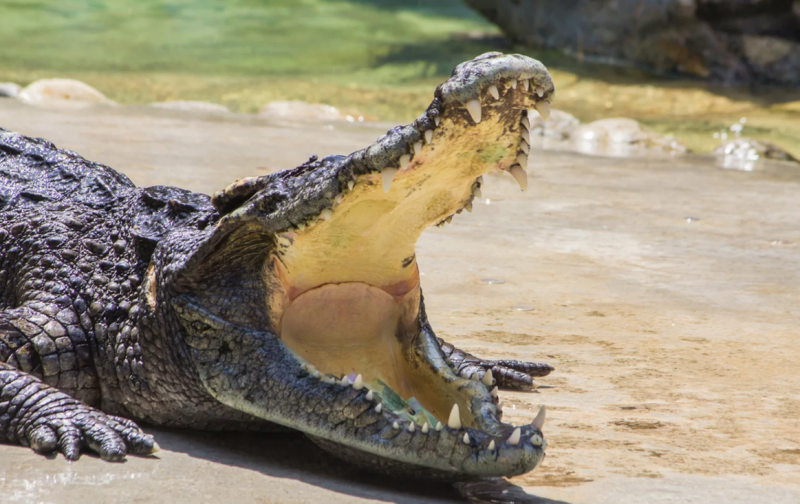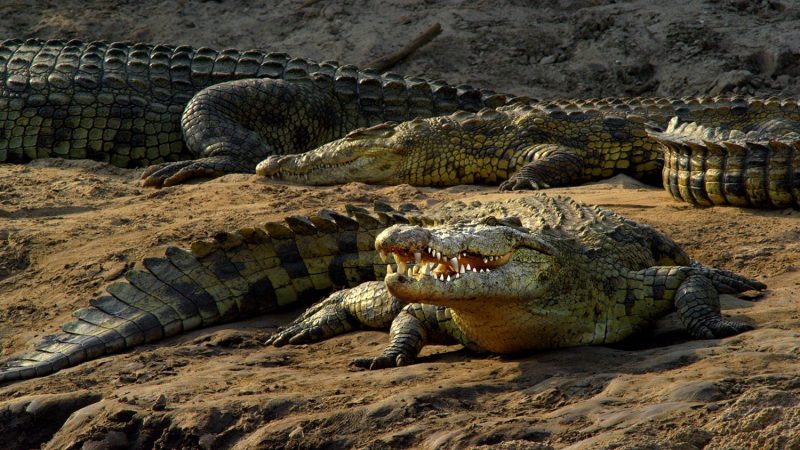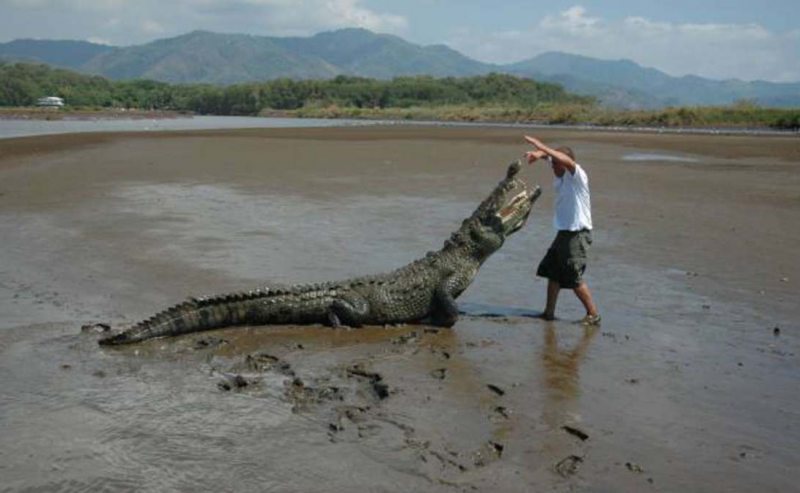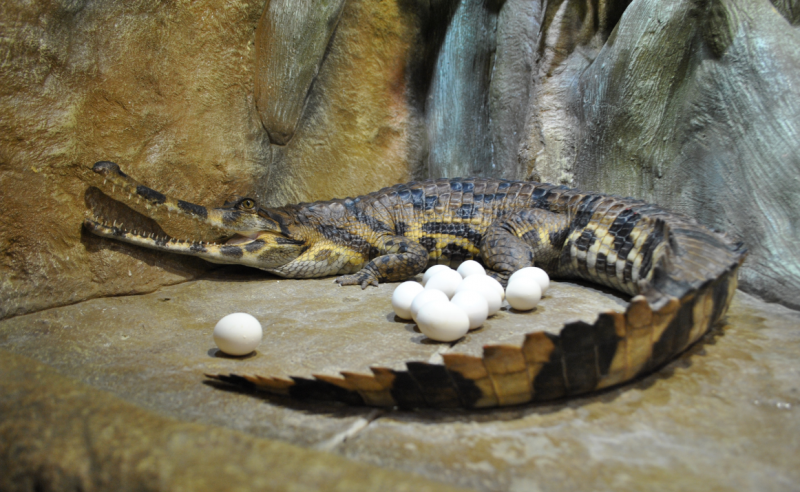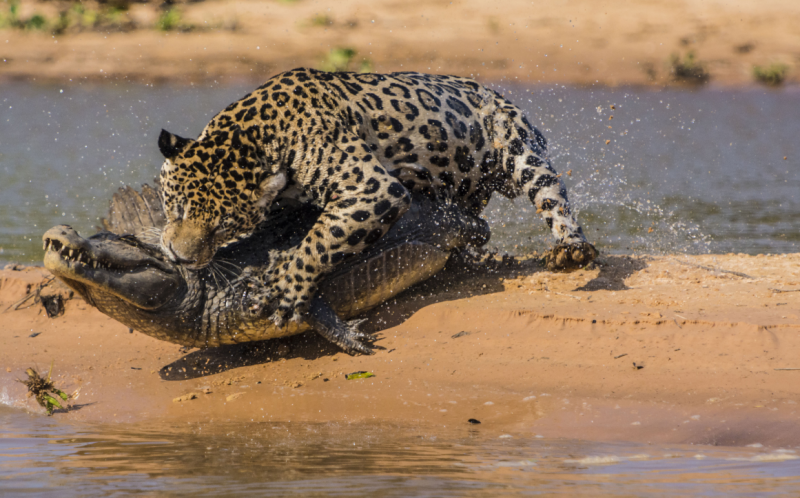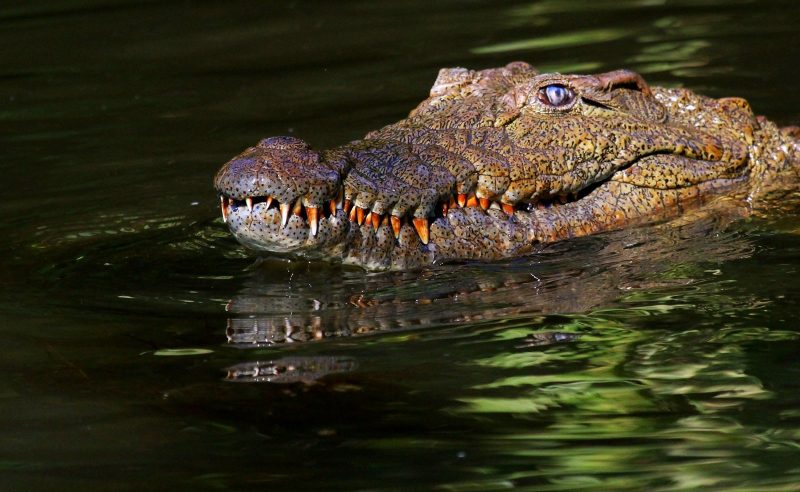The terrible and terrible Nile crocodile is the hero of numerous frightening tales of cannibal reptiles. This calls them to guard against the naughty children of Korney Chukovsky in his poem “Barmaley”. What is the danger of this giant dinosaur and what are the features of its appearance?
Material Content:
Description and features of the Nile crocodile
Nile crocodile - a reptile belonging to the family of real crocodiles. This species of reptile is one of the largest lizards that inhabit the African continent. In size, this crocodile is second only to combed.
It is interesting! The ancestor of all crocodiles are the dinosaurs themselves. By the structure of the skull and externally, these reptiles very much resemble ancient dinosaurs. Watching modern crocodiles, a person can get an idea of how dinosaurs looked like many millions of years ago.
Nile crocodile - part of the ecosystem of Africa. This cruel and ruthless predator is an excellent hunter and thunderstorm of most mammals and humans.
Anatomy and physiology
Like all other representatives of the toothy family, crocodiles from the shores of Africa are short-legged, with limbs and scaly skin located on the sides of the body. The latter is covered with skin plates arranged in rows. These crocodiles have powerful jaws and an impressive tail. The skull of a reptile has an elongated shape.
It is interesting! Until recently, heated debate did not subside around the body length of the Nile crocodile. Some researchers claim to have encountered individuals 9 meters long.But this miracle of nature was not documented, and the official record holder is a giant who was caught and killed in 1948 near Lake Victoria. The length of his body was 6.45 m, and the weight of a giant Nile crocodile was about 1.5 tons.
The average size of the Nile crocodile is 4.5-5.5 m with a weight of 600-1000 kg. Females reach a length of 2.2-3.8 m with a body weight of 200-400 kg.
The soft color allows the lizard to remain invisible. The surface of the body of the reptile is covered with grayish or brownish skin with dark spots on the tail and back. Characteristically, young crocodiles have a clearer picture and lighter skin. The lizard belly has a yellowish tint.
The four-chamber heart of an African crocodile helps to saturate its blood with oxygen, so that the reptile is immersed deeply under water for several minutes. A crocodile can be in the water near the surface from 40 minutes to 2 hours.
These dinosaurs do not have very sharp vision, which is offset by a very sensitive hearing. Their eyes are covered with a protective eyelid, next to which there are special glands that secrete fluid for washing the organs of vision.
On a note! Nile crocodile can run on land. Young individuals travel at a speed of 12-14 km / h for relatively short distances. As for swimming, here the crocodile is undoubtedly faster and moves with the help of a massive tail at a speed of up to 35 km / h.
Reptile species
There are several varieties of Nile crocodiles:
- East African
- West African
- South African
- Ethiopian;
- Kenyan;
- Central African
- Malagasy.
It is interesting! The last variety of the Nile crocodile on the list is recognized as very rare, since these reptiles are almost completely destroyed by humans. The remains of a population of these animals live in Madagascar and are worshiped by local Aborigines.
Lifestyle & Habitat
All African lizards are loners, leading a sedentary lifestyle and spending most of the time in water, on the surface of which eyes, ears and nostrils are exposed. Day and morning, reptiles bask in the sun, thereby helping their bodies maintain the right body temperature. In inclement weather and rainy season, crocodiles hardly get out of the water. In a dry season or during a cold snap, they dig a hole, place it in it and hibernate.
The Nile crocodile lives in lakes, rivers and swamps, dispersed throughout almost all of Africa, except the northern part. Reptiles also live in the states considered island: Mauritius, Zanzibar, Ethiopia, Kenya, Somalia, Morocco.
Note! Several decades ago, reptiles lived in southwest Asia, but over time, their population was destroyed.
The behavior and nutrition of reptiles
The diet of the Nile dinosaur includes water animals: fish, crabs, crayfish, mollusks, frogs, as well as insects: crickets, dragonflies, water bugs. Able to bite a crocodile as well as birds (marabou, stork, ostrich, etc.).
But the main food of the dinosaurs are mammals, small and large:
- the bats;
- antelopes (gazelles, kudu, etc.);
- reed rats;
- Hares
- mongooses
- monkey;
- forest pigs;
- aardvarks.
Crocodiles also attack hippos, zebras, giraffes, hyenas, large cats, buffalos, elephants and rhinos.
Note! Nile crocodiles are able to eat carrion stolen from hyenas or lions.
Crocodile is a great hunter. Due to the lightning fast attack of the dinosaur, the victim is often caught off guard. Suddenly closing his terrible jaws, the crocodile practically leaves no chance for prey to escape.
Note! Despite the penchant for a solitary lifestyle, crocodiles can hunt together. One of the predators keeps the prey caught, while the others grab pieces of meat from the carcass, while rotating around its axis. Such a crocodile technique was called "deadly rotation."
These predators are characterized by a slow metabolism and therefore can starve for a long time. However, subject to a successful hunt, an adult crocodile can eat about 20% of its body weight.
Bite Force and Attack on People
Nile dinosaurs are not particularly bloodthirsty in relation to humans, in comparison with other varieties of crocodiles. However, they account for a certain number of people killed per year.
It is interesting! The Nile crocodile Gustav, a cannibal living in Burundi (Central Africa), is recognized as an ominous record holder. Over his nearly 60-year life, he has killed about 400 people. The dangerous lizard is listed in the Guinness Book of Records and has not been caught until now, although traces of bullets and penetrating wounds can be traced on its body.
The crocodile’s most formidable weapon is, of course, its terrible mouth, studded with sharp teeth in the shape of a cone. Their total number can vary between 64-68 pcs. The strength of the bite of the Nile dinosaur is 340 atmospheres.
For comparison, the bite strength of other animals is given below:
- hippo - 124 atmospheres;
- Jaguar - 136 atmospheres;
- Mississippi alligator - 144 atmospheres;
- combed crocodile - 251 atmosphere.
Thus, in terms of attack power, the Nile crocodile surpasses all creatures living on the earth, even combed relatives, although inferior to them in size.
Reproduction and longevity
Nile crocodiles reach maturity at the age of 13-15 years, when females grow 2-2.5 m in length and males grow up to 2.5-3 m. Reptiles living in the north of the African continent begin to mate in the summer, "southerners" in November-December.
Trying to charm the female crocodile, the males snort, roar, slap their faces in the water, and make unusual trills. Crocodile lady prefers large males.
Competing for the female, males play a serious rivalry. Opponents arch their necks, slap their tails in the water and make menacing sounds. The defeated lizard is trying to swim away from the pursuit of the winner with maximum speed. If the escape fails, the defeated enemy raises his head up, leaving his throat defenseless. This position is considered a sign of defeat.
Females lay eggs on the shallows and sandy beaches near the water. Digging out a nest with a depth of approximately 60 cm, the expectant mother lays 30-90 eggs and buries them. Throughout the time until the hatching of the offspring, the female faithfully guards the masonry, not even leaving for food.
Small crocodiles have on their face an unusual outgrowth, similar to a tooth. He helps them break through the eggshell. Having made their way, the kids make characteristic sounds, and the female begins to dig out the masonry. A mother brings newborn babies to a reservoir in her mouth.
The female takes care of the babies until they are one year old. Matured lizards, the length of which at that time exceeds 1 m, leave the mother and enter an independent life.
Nile crocodiles live an average of 40-60 years. Individual individuals are able to live up to 80 years.
Natural enemies
Adult Nile crocodile almost no enemies. The exception is their brothers: between quarrels a quarrel may break out during a hunt. In addition, crocodiles are prone to cannibalism and are able to eat each other. The main enemy of the Nile crocodile was and remains, of course, man.
At the same time, the eggs of the Nile reptile are more vulnerable: they are threatened by birds of prey, monitor lizards, mongooses. Crocodile cubs can become prey for large cats, monitor lizards, baboons and other predators.
Interesting Facts
Crocodiles are the oldest reptiles that managed to adapt to life in various historical periods.
Naturalists and scientists have identified several interesting facts about these dinosaurs:
- Crocodiles living in the Nile were especially popular with the ancient Egyptians. They even worshiped the Nile deity named Sebek. He was portrayed as a man with the head of a pangolin. It is not surprising that the Egyptians revered these animals, turning them on as pets.After the death of the crocodiles turned into a mummy and buried with all sorts of honors.
- Crocodiles can get along well within the same pond with hippos. Moreover, female hippopotamus without fear leave their cubs near the lizards in order to protect themselves from other predators.
- These reptiles also “collaborate” with some birds, including the Egyptian runner and the lapwing. Widely opening its mouth, the lizard provides an opportunity for the feathered to remove the remains of meat from its teeth.
- In the mid-20th century, crocodiles underwent mass destruction. Reptiles were exterminated not only because of the value of their skin, but also for the purpose of extracting their meat, which is considered edible. In those days, the population of these creatures was on the verge of destruction.
- Today, the Nile crocodile is an inhabitant of the International Red Book.
The terrifying Nile crocodiles fully justify their reputation as dangerous predators. Their attacks should be feared not only by animals, but also by humans. Fearless and dexterous, this lizard is a wonderful hunter, rarely releasing prey from his terrible teeth.


